Discover 35 hidden attractions, cool sights, and unusual things to do in St. Augustine (United States). Don't miss out on these must-see attractions: Castillo de San Marcos, World Golf Hall of Fame, and St. Augustine Light. Also, be sure to include Medieval Torture Museum in your itinerary.
Below, you can find the list of the most amazing places you should visit in St. Augustine (Florida).
Table of Contents
Castillo de San Marcos
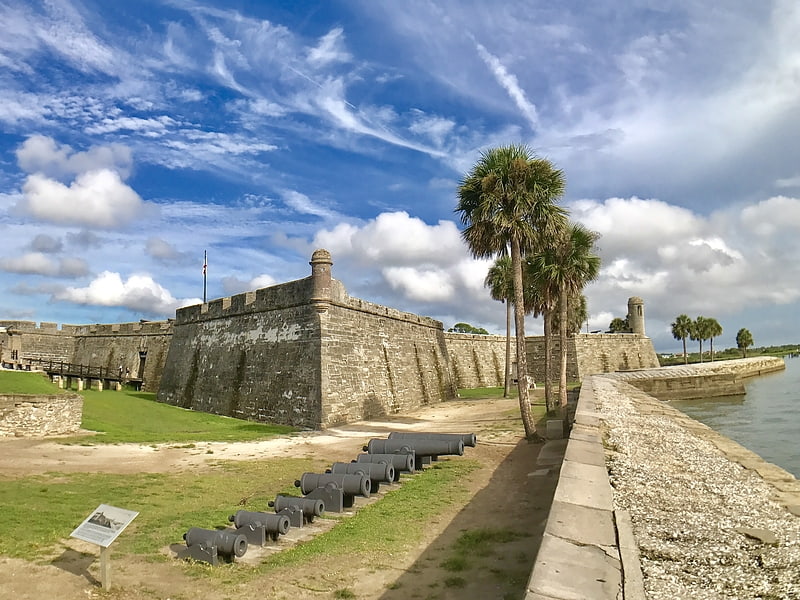
17th-century fortress with drawbridges. The Castillo de San Marcos is the oldest masonry fort in the continental United States; it is located on the western shore of Matanzas Bay in the city of St. Augustine, Florida.
It was designed by the Spanish engineer Ignacio Daza, with construction beginning in 1672, 107 years after the city's founding by Spanish Admiral and conquistador Pedro Menéndez de Avilés, when Florida was part of the Spanish Empire. The fort's construction was ordered by Governor Francisco de la Guerra y de la Vega after a raid by the English privateer Robert Searles in 1668 that destroyed much of St. Augustine and damaged the existing wooden fort. Work proceeded under the administration of Guerra's successor, Manuel de Cendoya in 1671, and the first coquina stones were laid in 1672. The construction of the core of the current fortress was completed in 1695, though it would undergo many alterations and renovations over the centuries.
Though built in part by Black slaves owned by the Spanish, the fort later served as one of the first entry points of fugitive slaves from British North America into Spanish Florida, where they were freed by the colonial authorities. This quickly led to the first free Black settlement in the future United States (Fort Mose, formed just north of St Augustine).
When Britain gained control of Florida in 1763 pursuant to the Treaty of Paris, St. Augustine became the capital of British East Florida, and the fort was renamed Fort St. Mark until the Peace of Paris (1783) when Florida was transferred back to Spain and the fort's original name restored. In 1819, Spain signed the Adams–Onís Treaty which ceded Florida to the United States in 1821; consequently, the fort was designated a United States Army base and renamed Fort Marion, in honor of American Revolutionary War hero Francis Marion. The fort was declared a National Monument in 1924, and after 251 years of continuous military possession, was deactivated in 1933. The 20.48-acre (8.29 ha) site was subsequently turned over to the United States National Park Service. In 1942 the original name, Castillo de San Marcos, was restored by an Act of Congress.
Castillo de San Marcos was attacked several times and twice besieged: first by English colonial forces led by Carolina Colony Governor James Moore in 1702, and then by English Georgia colonial Governor James Oglethorpe in 1740, but was never taken by force. However, possession of the fort has changed five times, all peaceful, among four different governments: Spain, 1695–1763 and 1783–1821, Kingdom of Great Britain, 1763–1783, and the United States of America, 1821–date (during 1861–1865, under control of the Confederate States of America).
Under United States control the fort was used as a military prison to incarcerate members of Native American tribes starting with the Seminole—including the famous war chief, Osceola, in the Second Seminole War—and members of western tribes, including Geronimo's band of Chiricahua Apache. The Native American art form known as Ledger Art had its origins at the fort during the imprisonment of members of the Plains tribes such as Howling Wolf of the southern Cheyenne.
Ownership of the Castillo was transferred to the National Park Service in 1933, and it has been a popular tourist destination since then.[1]
Address: 1 S Castillo Dr, 32084 St. Augustine
World Golf Hall of Fame

Museum in St. Johns County, Florida. The World Golf Hall of Fame is located at World Golf Village near St. Augustine, Florida, in the United States, and it is unusual among sports halls of fame in that a single site honors both men and women. It is supported by a consortium of 26 golf organizations from all over the world.
The Hall of Fame Museum Building was designed by the specialist museum architecture firm E. Verner Johnson and Associates of Boston. They also produced the museum master plan that established the size, mission and qualities of the museum and the surrounding facilities and site.
The Hall of Fame Museum features a permanent exhibition and a rolling program of temporary exhibitions. Designed by museum design firm Ralph Appelbaum Associates, the Hall of Fame and exhibition area contains exhibits on the game's history, heritage, and techniques; major players and organizations; golf course design, equipment, and dress.[2]
Address: 1 World Golf Pl, 32092 St. Augustine
St. Augustine Light
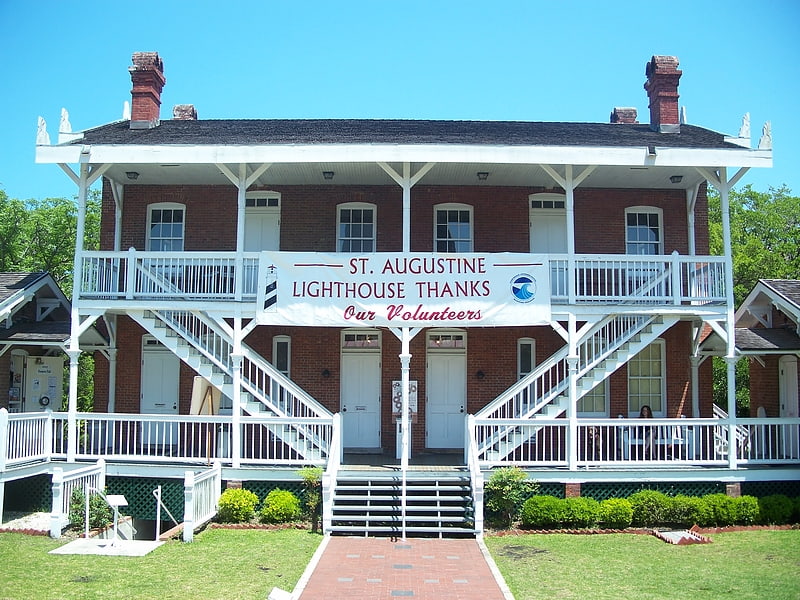
Lighthouse in St. Augustine, Florida. The St. Augustine Light Station is a private-aid to navigation and an active, working lighthouse in St. Augustine, Florida. The current lighthouse stands at the north end of Anastasia Island and was built between 1871 and 1874. The tower is the second lighthouse tower in St. Augustine, the first being lit officially by the American territorial government in May 1824 as Florida's first lighthouse. However, both the Spanish and the British governments operated a major aid to navigation here including a series of wooden watch towers and beacons dating from 1565.
The current lighthouse tower, original first-order Fresnel Lens and the Light Station grounds are owned by the St. Augustine Lighthouse & Maritime Museum, Inc., a not-for-profit maritime museum. The museum is open to the public 360 days a year. Admission fees support continued preservation of the lighthouse and five other historic structures. Admissions and museum memberships also fund programs in maritime archaeology, traditional wooden boatbuilding, and maritime education. The non profit mission is to "discover, preserve, present and keep alive the stories of the nation's oldest port as symbolized by our working St. Augustine Lighthouse."[3]
Address: 81 Lighthouse Ave (100 Red Cox Road for GPS), 32080 St. Augustine
Medieval Torture Museum
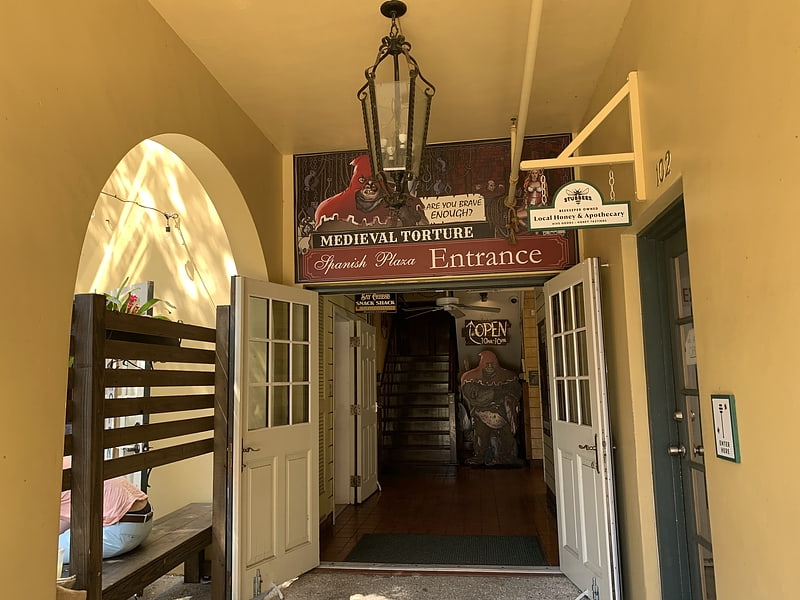
The Medieval Torture Museum is the largest interactive torture museum in the United States, displaying a private collection of torture, execution and restraint devices. The museum is a product of BenAur company and is located in the cities of St. Augustine and Chicago.[4]
Cathedral Basilica of St. Augustine
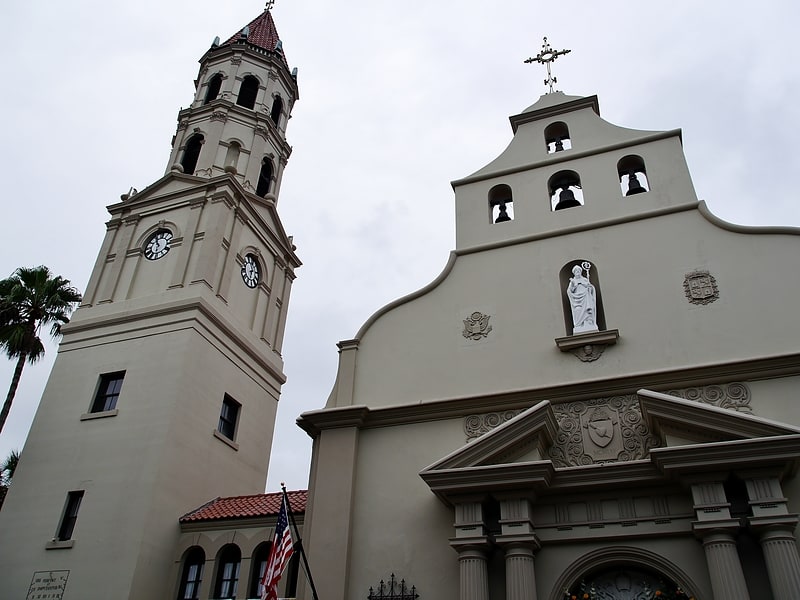
Cathedral in St. Augustine, Florida. The Cathedral Basilica of St. Augustine is a historic cathedral in St. Augustine, Florida, and the seat of the Catholic Bishop of St. Augustine. It is located at 38 Cathedral Place between Charlotte and St. George Streets. Constructed over five years, it was designated a U.S. National Historic Landmark on April 15, 1970. Its congregation, established in 1565, is the oldest Christian congregation in the contiguous United States.[5]
Address: 38 Cathedral Place, 32084 St. Augustine
Oldest Wooden Schoolhouse
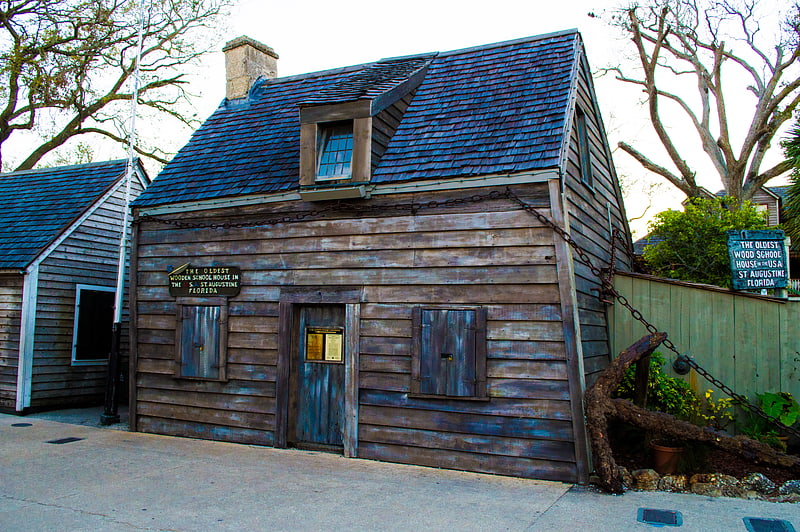
The Oldest Wooden School House is a wooden structure located at 14 St. George Street in St. Augustine, Florida near the city gate. It is touted as being the oldest wooden school building in the United States. The exact date of construction is unknown, but it first appears on tax records in 1716. There are no extant wooden buildings in St. Augustine built prior to 1702 when the British burned the city. The oldest schoolhouse still standing in the United States is the Voorlezer's House built prior to 1696 and located in Historic Richmondtown in Staten Island, New York.
The building is encircled by a large chain, placed there in 1937, to help anchor it to the ground in case of a hurricane. The walls are made of bald cypress and red cedar which are held together by wooden pins and iron spikes, however, recent maintenance has replaced the roofing, among other fixes.
The schoolmaster and family lived on the second floor above the classroom and the kitchen was located in a separate building to reduce heat and threat of fire. The building originally belonged to Juan Genoply. The classroom was one of the first in the US to be co-ed, educating both boys and girls since 1788.[6]
Address: 14 Saint George St, 32084 St. Augustine
St. Augustine Alligator Farm Zoological Park
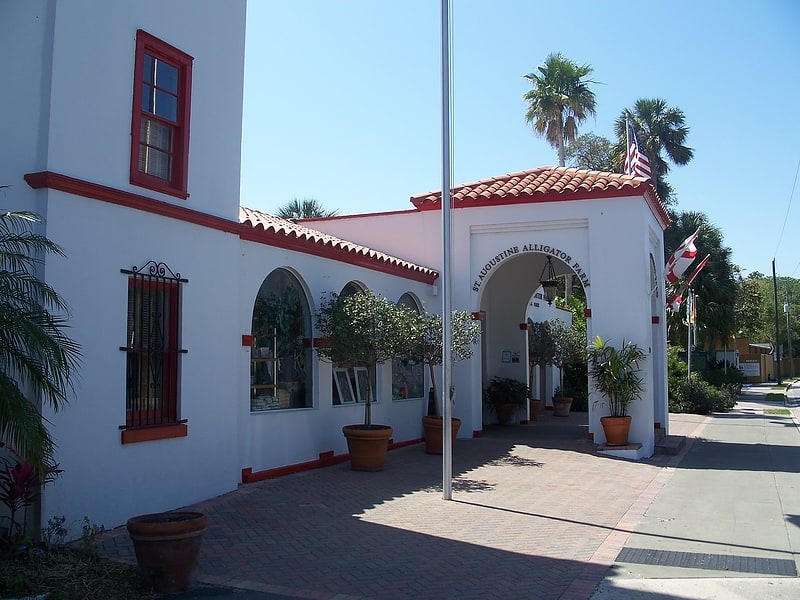
Landmark with gator shows and zip lines. The St. Augustine Alligator Farm Zoological Park is one of Florida's oldest continuously running attractions, having opened on May 20, 1893. It has 24 species of crocodilians, and also a variety of other reptiles, mammals and birds, as well as exhibits, animal performances and educational demonstrations.[7]
Address: 999 Anastasia Blvd, 32080 St. Augustine
González–Álvarez House
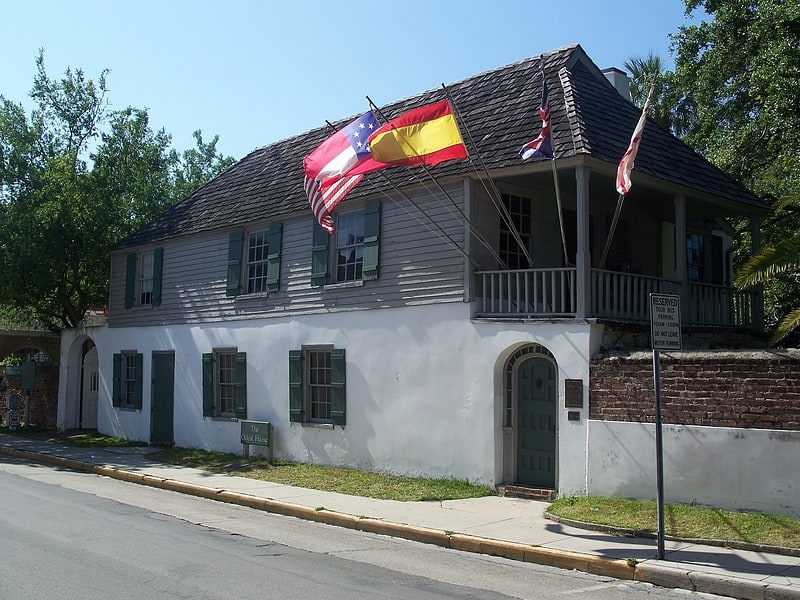
Museum in St. Augustine, Florida. The González–Álvarez House, also known as The Oldest House, is a historic house museum at 14 St. Francis Street in St. Augustine, Florida. With a construction history dating to about 1723, it is believed to be the oldest surviving house in St. Augustine. It is also an important example of St. Augustine's Spanish colonial architectural style, with later modifications by English owners. It was designated a U.S. National Historic Landmark in 1970. The house is now owned by the St. Augustine Historical Society and is open for public tours as part of the Oldest House Museum Complex. Evidence can be seen of the Spanish, British, and American occupations of St. Augustine.[8]
Lightner Museum

Museum in St. Augustine, Florida. The Lightner Museum is a museum of antiques, mostly American Gilded Age pieces, housed within the historic Hotel Alcazar building in downtown St. Augustine. This 1887 Spanish Renaissance Revival style building is listed on the National Register of Historic Places.[9]
Address: 75 King St, 32084 St. Augustine
Mission Nombre de Dios
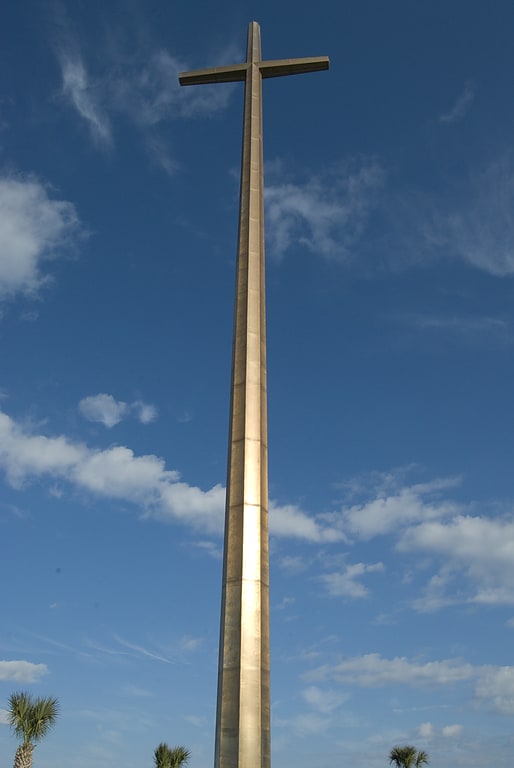
Museum in St. Augustine, Florida. Mission Nombre de Dios is a Catholic mission in St. Augustine, Florida, on the west side of Matanzas Bay. It is part of the Diocese of St. Augustine and is likely the oldest mission in the continental United States. The National Shrine of Our Lady of La Leche, the oldest shrine in that region, is located on the mission grounds.[10]
Address: 27 Ocean Ave, 32084-2812 St. Augustine
Ximenez-Fatio House
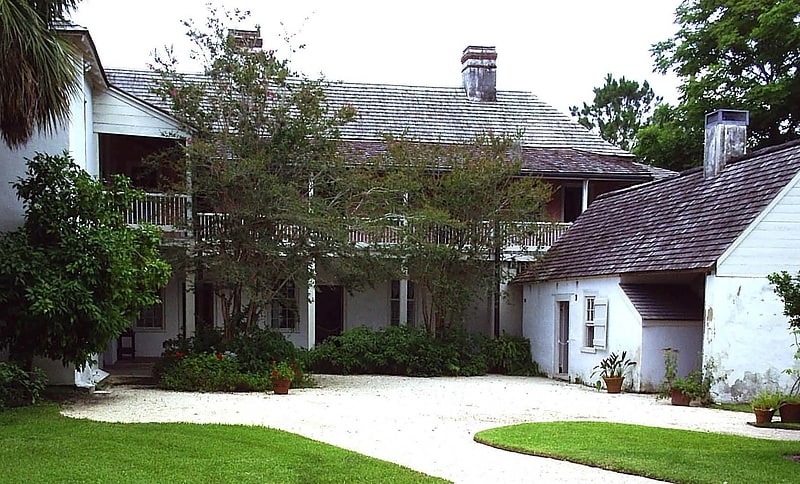
Museum in St. Augustine, Florida. Ximenez-Fatio House Museum is one of the best-preserved and most authentic Second Spanish Period residential buildings in St. Augustine, Florida. In 1973, it was added to the National Register of Historic Places. It was designated a Florida Heritage Landmark in 2012. The museum complex sits just south of the city's central Plaza de la Constitución at 20 Aviles Street, the oldest archaeologically documented street in the United States. It is located at the center of Old Town, the city's oldest continuously occupied community. Since 1939, the property has been privately owned and managed by The National Society of The Colonial Dames of America in The State of Florida. Through their efforts, it was restored and interpreted to reflect its function as a fashionable boarding house during Florida's first tourist boom, which began after 1821. The property is a historic house museum, furnished and presented to tell stories of the visitors who lodged there, the women who owned and managed it, and how people lived during Florida's territorial period.[11]
Address: 20 Aviles St, 32084 St. Augustine
Avero House
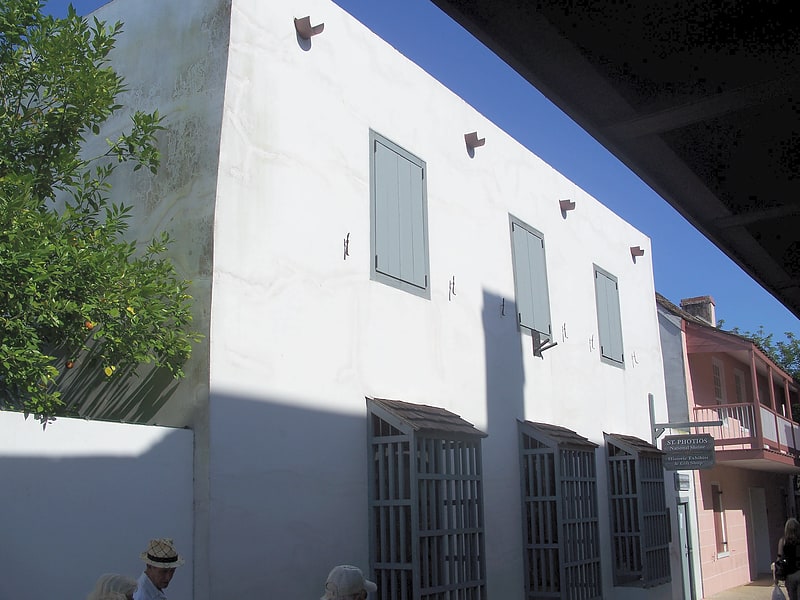
Building in St. Augustine, Florida. The Avero House is a historic house located at 41 St. George Street in St. Augustine, Florida, United States. The building is locally significant as one of 30 remaining houses within the historic district that pre-date 1821. It was once the site of a Minorcan Chapel. Today, the building is home to the St. Photios Greek Orthodox National Shrine.[12]
Address: 41 Saint George St, 32084-3607 St. Augustine
Fountain of Youth Archaeological Park

The Fountain of Youth Archaeological Park is a privately owned 15-acre park in St. Augustine, Florida, located along Hospital Creek, part of the Intracoastal Waterway. It has been touted as the likely 1513 Florida landing site of Spanish explorer Ponce de Leon, although no evidence has been found to substantiate this claim. Recent research by amateur historian Douglas Peck has placed another possible landing site in the vicinity of Melbourne Beach in Brevard County.
The park contains a well claimed to be the freshwater source referred to by Antonio de Herrera y Tordesillas in his Historia general de los hechos de los castellanos en las Islas y Tierra Firme del mar Océano and supposedly sought by Ponce de Leon, but there is no supporting evidence. Archaeological excavations made by Dr. Kathleen Deagan on the park's grounds in the 1990s uncovered remains of the first Spanish settlement and its fortifications in St. Augustine.[13]
Address: 11 Magnolia Ave, 32084 St. Augustine
Villa Zorayda Museum
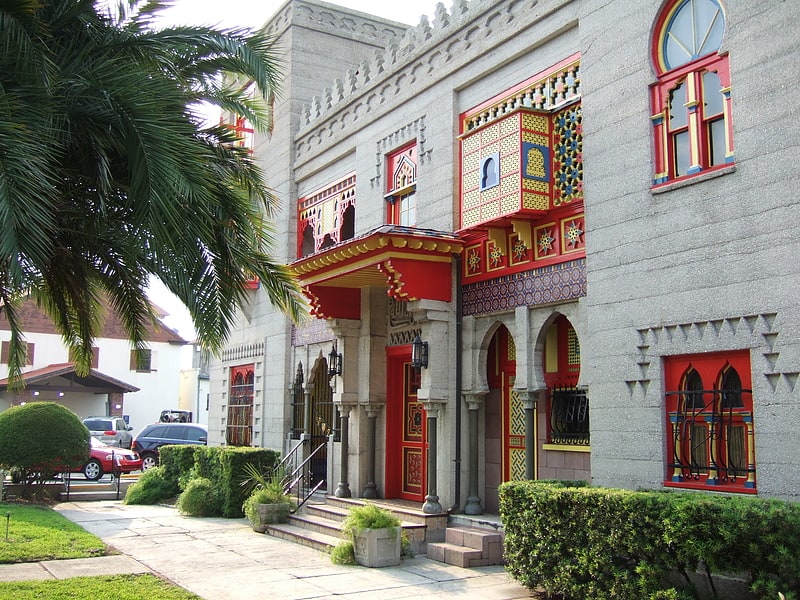
Home in St. Augustine, Florida. Villa Zorayda is a house at 83 King Street in St. Augustine, Florida. Built in 1883 by the eccentric Boston millionaire Franklin W. Smith as his winter home, it was inspired by the 12th-century Moorish Alhambra Palace in Granada, Spain. Smith named it "Villa Zorayda", after one of the princesses in Washington Irving's Tales of the Alhambra. The building and part of Franklin Smith's art and antique collection were sold to Abraham Mussallem, a rug and antiquities merchant originally from Syria, in 1913. On September 23, 1993, it was added to the U.S. National Register of Historic Places. The Villa Zorayda Museum is still owned by the Mussallem family and contains the original art and antique collection assembled by Franklin Smith and Abraham Mussallem.[14]
Address: 83 King St, 32084 St. Augustine
St. Augustine Pirate & Treasure Museum
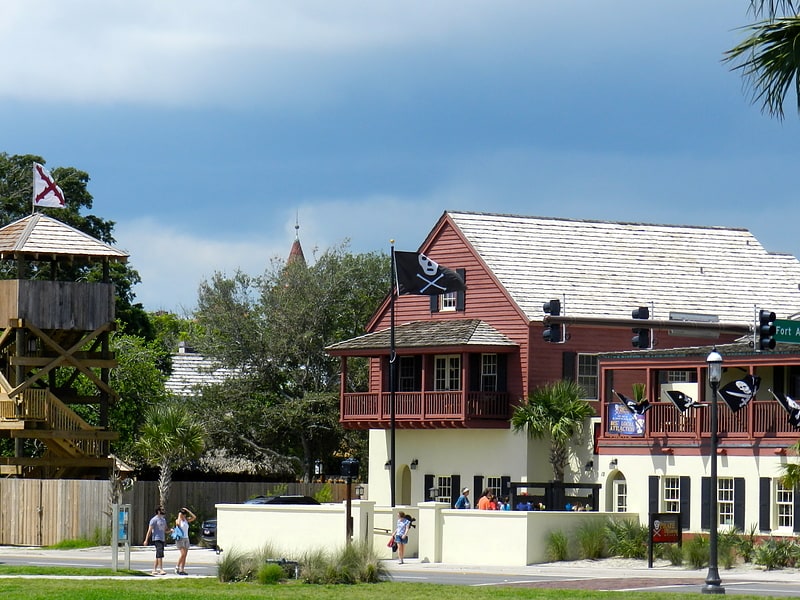
The St. Augustine Pirate & Treasure Museum is a museum dedicated to pirate artifacts.
Formerly known as the Pirate Soul Museum, the museum was located at 524 Front Street, Key West, Florida, United States. It was announced in February 2010 that the museum was being moved to St Augustine, Florida. It reopened there on December 8, 2010, as the St. Augustine Pirate & Treasure Museum.
The museum houses 48 individual exhibit areas, and over 800 artifacts inside. It has been proclaimed as the largest and most authentic collection of pirate artifacts ever displayed under one roof. Among its exhibits are Blackbeard's original blunderbuss, pieces of gold retrieved from his warship the Queen Anne's Revenge, one of only three remaining authentic Jolly Roger flags in the world, and Thomas Tew's original treasure chest, the only known authentic pirate treasure chest in the world.
In addition to the authentics, there are real cannons from the 1700s that guests are able to electronically fire off, as well as a Disney Imagineer's curated 3D Audio show, only existing in the St. Augustine Pirate and Treasure Museum. There are also tours offered on the weekends by "Pirate Tour Guides" throughout the day.
The museum was started by entrepreneur Pat Croce.[15]
Address: 12 S Castillo Dr, 32084 St. Augustine
O'Reilly House
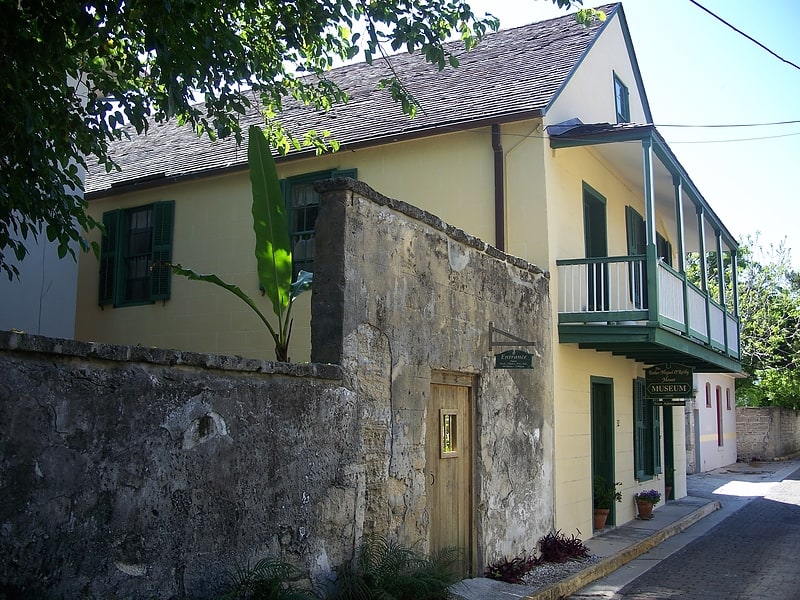
Museum in St. Augustine, Florida. The O'Reilly House, known officially known as the Father Miguel O'Reilly House Museum, and also known as the House of Don Lorenzo de Leon, is a historic home in St. Augustine, Florida. It is located at 131 Aviles Street. On October 15, 1974, it was added to the U.S. National Register of Historic Places.
The museum's exhibits focus on the Catholic heritage of St. Augustine.[16]
Address: 32 Aviles St, 32084-4445 St. Augustine
Old St. Johns County Jail
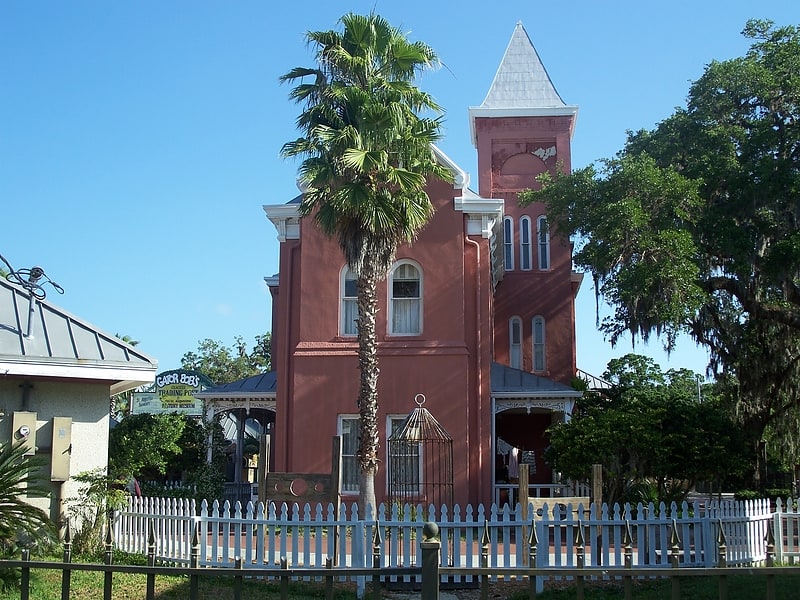
Jail in St. Augustine, Florida. The Old Jail is a historic jail in St. Augustine, Florida. It is located at 167 San Marco Avenue. On August 27, 1987, it was added to the U.S. National Register of Historic Places. The St. Johns County Jail now serves as the Old Jail Museum.[17]
Address: 167 San Marco Ave, 32084 St. Augustine
Memorial Presbyterian Church
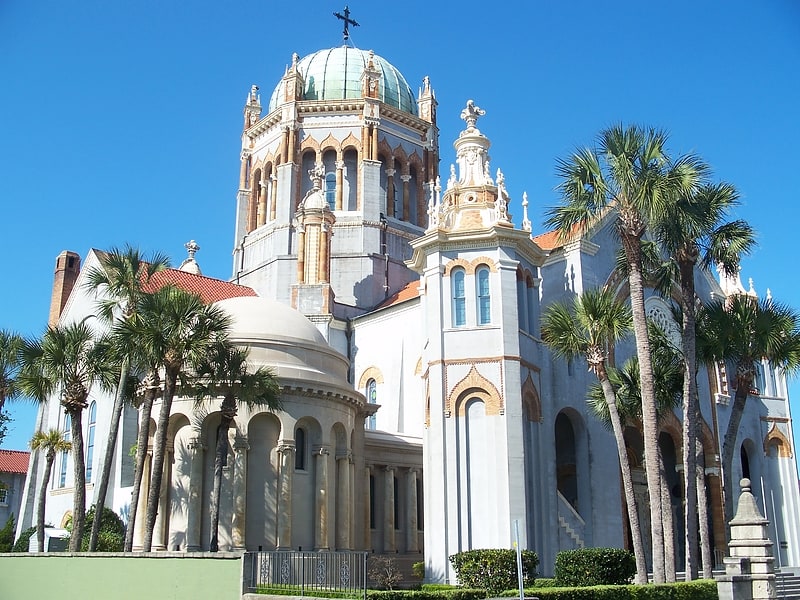
Presbyterian church in St. Augustine, Florida. The Memorial Presbyterian Church is a historic church constructed in St. Augustine, Florida, in 1889 by American industrialist Henry Morrison Flagler. It is located at 32 Sevilla Street. It was dedicated to the memory of his daughter Jennie Louise Benedict, who died following complications from childbirth at sea in March 1889.[18]
Address: 32 Sevilla St, 32084 St. Augustine
Government House

Museum in St. Augustine, Florida. Government House, also known as Governor's House, is located at 48 King Street in St. Augustine, Florida, adjacent to the Plaza de la Constitución. The building, constructed of coquina, served as the governor's official residence from c. 1710 during the First Spanish Period, throughout the British Period, and until 1812 in the Second Spanish Period. Governor Gonzalo Méndez de Canzo was the first governor to build his residence on the present Government House site in 1598.
A new structure was built on the site in 1706 for use as a residence, office, courthouse, and the social center of the town. The east wing of the present building dates to the original construction between 1706 and 1713. Due to the 1763 Treaty of Paris, Florida passed into British ownership. During the British Period, the house was the official residence of James Grant, the British royal governor of East Florida (1764–1771). Among his guests were American explorer Daniel Boone, who was in East Florida to inquire about land purchases, and Patrick Tonyn, who was appointed as Grant's successor.
At the close of the American Revolution, Florida and St. Augustine were returned to Spain by the 1783 Treaty of Paris. General Nathanael Greene visited Government House in 1784, hosted for an elaborate seven-course meal by Governor Vicente Manuel de Zéspedes. From 1785–87 the governor’s residence again underwent major renovation. The last governor to use the house was Enrique White during the Second Spanish Period; he died in 1811.
By the time Florida was annexed by the United States in 1821, the building was in ruins with only the walls remaining. In 1833–34 Government House was rebuilt with federal funds, following plans drawn up by architect Robert Mills, later famous for designing the Washington Monument. The structure incorporated existing walls and contained 16 rooms, including space for a post office, a courtroom, and other federal functions. During the American Civil War federal troops were headquartered in the building.
In 1873 another major remodeling took place, using plans by architect William M. Kimball. Through the next 60 years the post office and customs house gradually took over more and more of the building as the town grew. In 1937, Government House was once again renovated by Jacksonville architect Mellen Clark Greeley as a Works Progress Administration (WPA) project. The U.S. Postal Service continued to use the building until 1965, when a new post office building was constructed. Government House was transferred to the State of Florida in February 1966 as a public monument to be administered by the St. Augustine Historical Restoration and Preservation Commission (later renamed the Historic St. Augustine Preservation Board).
The Historic St. Augustine Preservation Board used the 1937 wing of the building for a research library, archaeological and curatorial laboratories, and historical displays until the board became defunct in 1997. Today, the ground floor of the building is open to the public as Governor’s House Cultural Center and Museum, managed by UF Historic St. Augustine, Inc. A research library managed by the George A. Smathers Libraries at the University of Florida is housed on the second floor.
During their tour of St. Augustine on April 1, 2001, King Juan Carlos and Queen Sofía of Spain made a public appearance on the east balcony of Government House. King Felipe VI and Queen Letizia of Spain also visited Government House on September 17, 2015.
Government House was added to the National Register of Historic Places on January 7, 2014.[19]
Address: 48 King St, 32084-4449 St. Augustine
Bridge of Lions
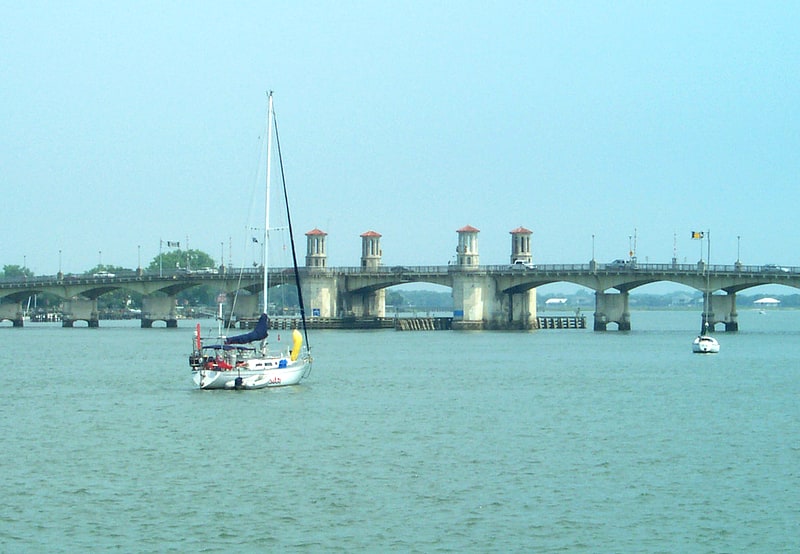
Bascule bridge in St. Augustine, Florida. The Bridge of Lions is a double-leaf bascule bridge that spans the Intracoastal Waterway in St. Augustine, Florida, United States. A part of State Road A1A, it connects downtown St. Augustine to Anastasia Island across Matanzas Bay. A pair of copies of the marble Medici lions guard the bridge, begun in 1925 and completed in 1927. They were removed in February 2005 and returned in March 2011.
Roads & Bridges magazine named the Bridge of Lions as fourth in the nation's top 10 bridges for 2010. Projects were evaluated based on size, community impact and challenges resolved.
The United States Department of Transportation declared the bridge "structurally deficient and functionally obsolete" in 1999, prompting heated debates on what to do with the structure. A restoration plan was approved, but opponents continued to voice their opposition. Reynolds, Smith & Hills from nearby Jacksonville was awarded the engineering and design contract, estimated at $77 million, and projected to require five years to complete.[20]
Address: 20 Bridge of Lions, 32084 St. Augustine
Huguenot Cemetery
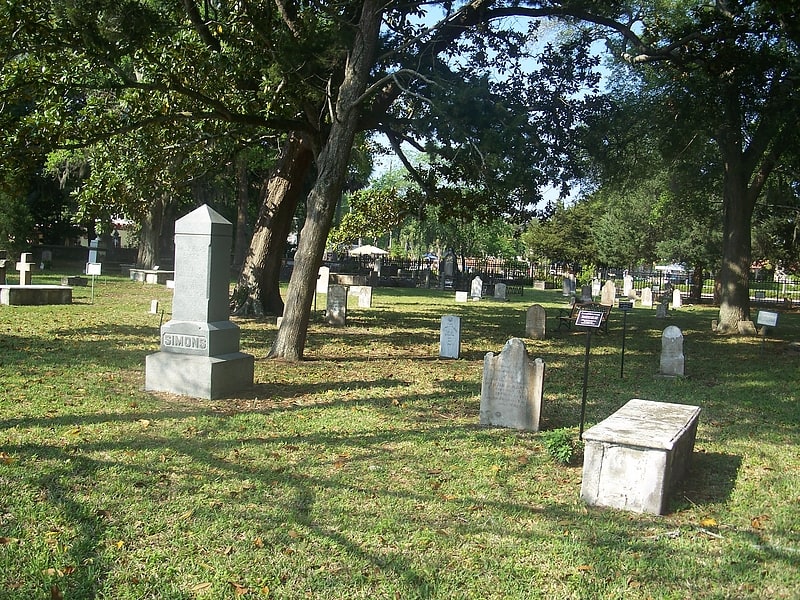
Cemetery in St. Augustine, Florida. The Huguenot Cemetery in St. Augustine, Florida located across from the historic City Gate was a Protestant burial ground between the years 1821 and 1884. The Spanish colonial city of St. Augustine, along with the entire Florida Territory became de facto American possessions after the 1819 signing of the Adams-Onis Treaty. The actual physical occupation of the city and Florida territory occurred in 1821.
Prior to American occupation the Spanish city of St. Augustine was predominately Catholic and the only burial ground within the city, the Tolomato cemetery, was reserved for Catholics. Recognizing a need for a formal Protestant burial ground an area just outside the city gate was chosen by the new American administration in St. Augustine. The first burials occurred in 1821 just prior to a yellow fever epidemic which claimed the lives of a large numbers of the city's inhabitants.
The cemetery until title to the cemetery property was acquired by the Rev. Thomas Alexander, who then turned over it to the Presbyterian Church in 1832, burials continued until 1884 when both Huguenot and Tolomato cemeteries were closed. The cemetery is believed to hold at least 436 burials according to city records. The cemetery although named "Huguenot Cemetery" isn't believed to contain any members of the Huguenots, a French Protestant sect started in the 16th century in France.[21]
Address: 8 S Castillo Dr, St. Augustine
Potter's Wax Museum

Museum in St. Augustine, Florida. The Potter's Wax Museum is located at 31 Orange Street, St. Augustine, Florida, United States. It houses over 160 wax sculptures covering a wide range of real and fictitious figures, including famous politicians, entertainers, horror characters, historical personalities, sports stars and other celebrities. George L. Potter established the collection in 1948 and the attraction is the first wax museum in the United States.[22]
Address: 17 King St, 32084 St. Augustine
Flagler College
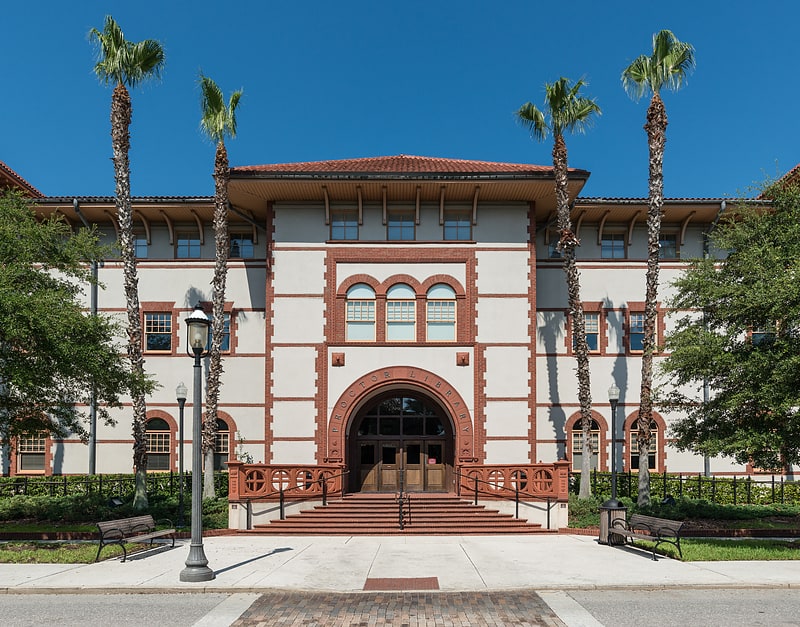
Liberal arts college in St. Augustine, Florida. Flagler College is a private liberal arts college in St. Augustine, Florida. It was founded in 1968 and offers 33 undergraduate majors and one master's program. It also has a campus in Tallahassee.[23]
Address: 74 King St, 32084-4342 St. Augustine
Fort Matanzas National Monument
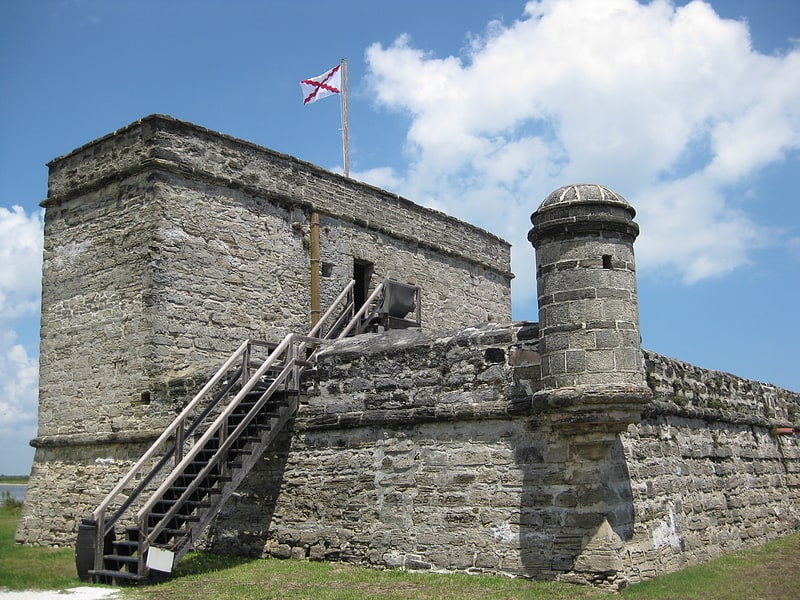
National monument in St. Johns County, Florida. Fort Matanzas National Monument was designated a United States National Monument on October 15, 1924. The monument consists of a 1740 Spanish fort called Fort Matanzas, and about 100 acres of salt marsh and barrier islands along the Matanzas River on the northern Atlantic coast of Florida. It is operated by the National Park Service in conjunction with the Castillo de San Marcos National Monument in the city of St. Augustine.[24]
Colonial Quarter
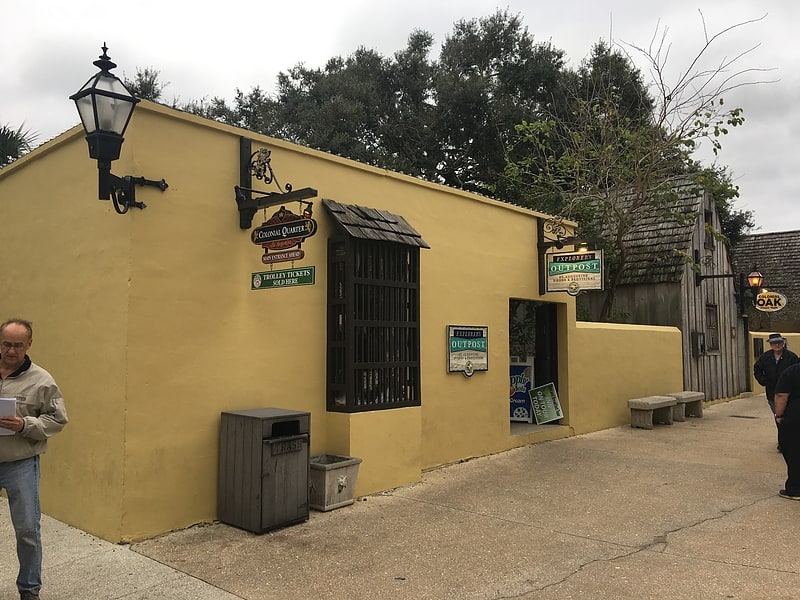
History museum in St. Augustine, Florida. The Colonial Quarter is a site in St. Augustine, Florida. After an extensive multimillion-dollar renovation completed in three months, the site opened as the Colonial Quarter in March 2013.[25]
Address: 33 Saint George St, 32084 St. Augustine
Oldest House Museum
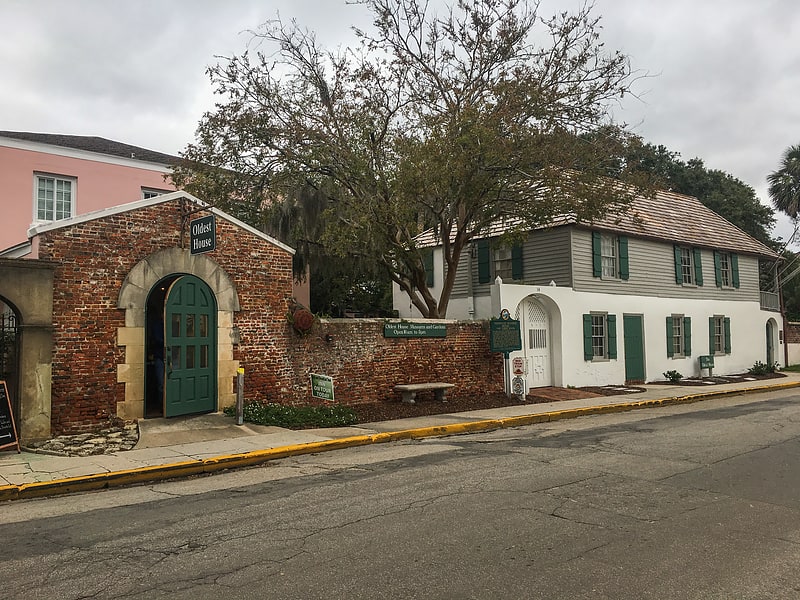
Museum in St. Augustine, Florida. For the Oldest House Museum in Key West, Florida see Old Island Restoration Foundation
The Oldest House Museum is located in St. Augustine, Florida in St. Johns County, Florida. It is operated by the St. Augustine Historical Society and includes the González-Alvarez House, the Manucy Museum (named for Albert Manucy) of local history and the Edwards Gallery.
The Oldest House, from which the museum derives its name, is located on a site that has been occupied since the 1600s. Formally known as the González-Alvarez House, it is the oldest surviving Spanish Colonial dwelling in Florida. The building dates back to the early 1700s. The house has been open to visitors since 1893. The United States Department of the Interior designated the house a National Historic Landmark in 1970.[26]
Address: 271 Charlotte St, 32084-5033 St. Augustine
Spanish Military Hospital Museum
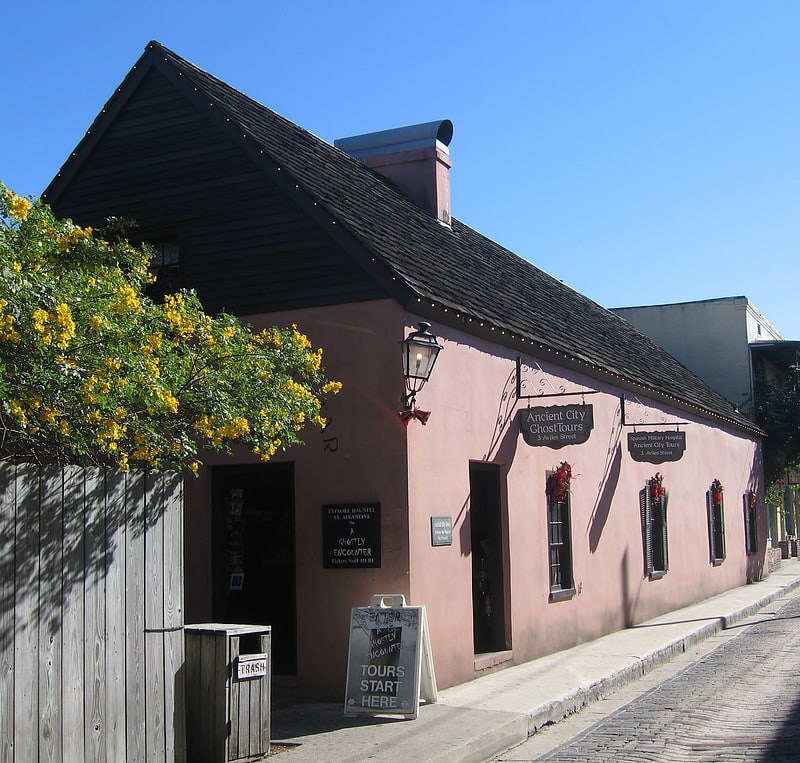
Museum in St. Augustine, Florida. The Spanish Military Hospital Museum is located at 3 Aviles Street, St. Augustine, Florida. The museum covers the Second Spanish Period medical practices. The museum is open seven days a week from 9am to 5pm. Tours start on demand throughout the day and cover a surgical demonstration, apothecary demonstration, and tours of a medicinal herb garden.[27]
Address: 3 Aviles St, 32084 St. Augustine
St. Augustine National Cemetery

Cemetery. St. Augustine National Cemetery is a United States National Cemetery located in the city of St. Augustine in St. Johns County, Florida. Located on the grounds of the active military installation known as St. Francis Barracks, the state headquarters of the Florida National Guard, it encompasses 1.4 acres, and as of the end of 2005 had 2,788 interments. Administered by the United States Department of Veterans Affairs, it is currently closed to new interments. It was listed on the National Register of Historic Places in 2016.[28]
Address: 104 Marine St, 32084 St. Augustine
Hispanic Garden
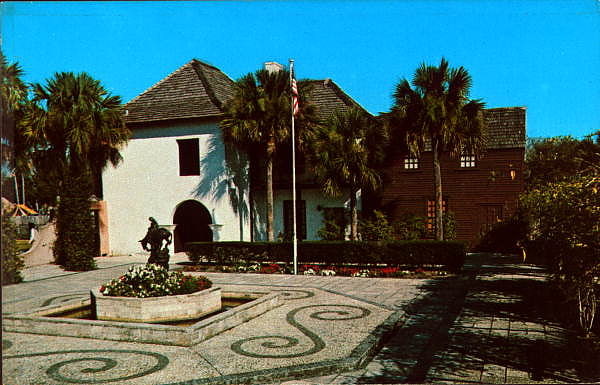
The Hispanic Garden is a garden in St. Augustine, Florida.[29]
Ripley's Believe It or Not!

Ripley's Believe It or Not! is an American franchise founded by Robert Ripley, which deals in bizarre events and items so strange and unusual that readers might question the claims. Originally a newspaper panel, the Believe It or Not feature proved popular and was later adapted into a wide variety of formats, including radio, television, comic books, a chain of museums and a book series.
The Ripley collection includes 20,000 photographs, 30,000 artifacts and more than 100,000 cartoon panels. With 80-plus attractions, the Orlando, Florida-based Ripley Entertainment, Inc. a division of the Jim Pattison Group a Canadian global company with an annual attendance of more than 12 million guests. Ripley Entertainment's publishing and broadcast divisions oversee numerous projects, including the syndicated TV series, the newspaper cartoon panel, books, posters and games.[30]
Address: 19 San Marco Ave, 32084 St. Augustine
Fort Mose Historic State Park
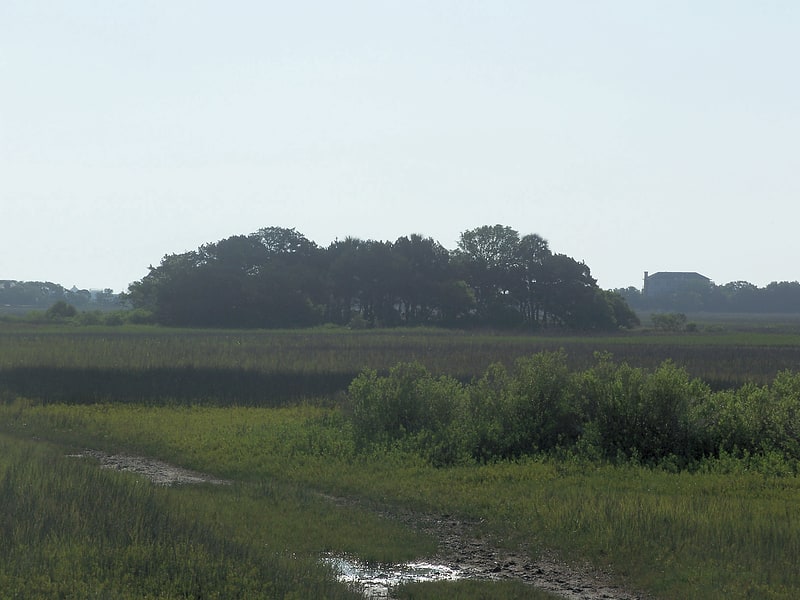
Vast park with an on-site history museum. Fort Mose Historic State Park is a U.S. National Historic Landmark, located two miles north of St. Augustine, Florida, on the edge of a salt marsh on the western side of the waterway separating the mainland from the coastal barrier islands. The original site of the 18th-century fort was uncovered in a 1986 archeological dig. The 24-acre site is now protected as a Florida State Park, administered through the Anastasia State Recreation Area. Fort Mose is the "premier site on the Florida Black Heritage Trail". In 1738, the Spanish governor of Florida, Manuel de Montiano, had Fort Mose constructed and established it as a free black settlement, the first to be legally sanctioned in what would become the territory of the United States. The fort has also been called Fort Moosa or Fort Mossa, variants of the Spanish pronunciation.[31]
Address: 15 Fort Mose Trl, 32084 St. Augustine
Marin-Hassett House
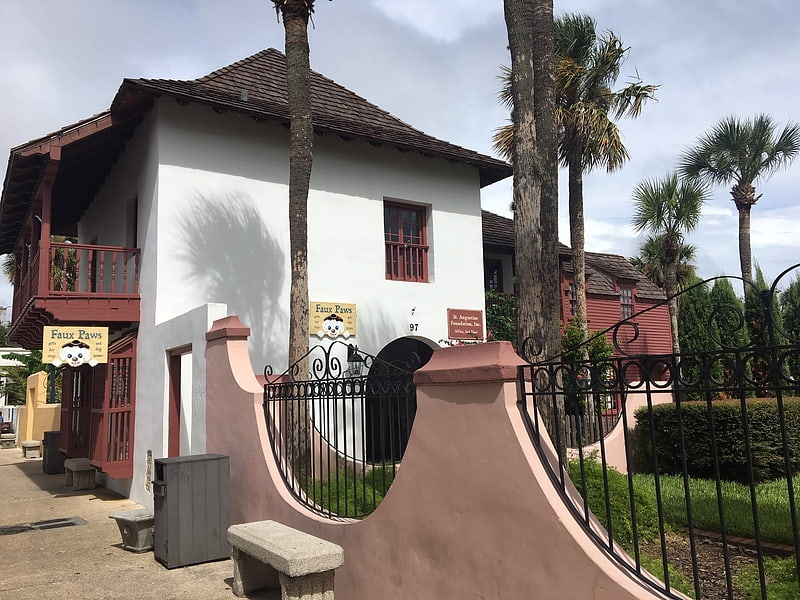
The Marin-Hassett House is located at 97 St. George Street in St. Augustine, Florida. It is reconstructed on its foundations that date to St. Augustine's First Spanish Period.[32]
Address: 97 St. George Street, St. Augustine
Trinity Parish
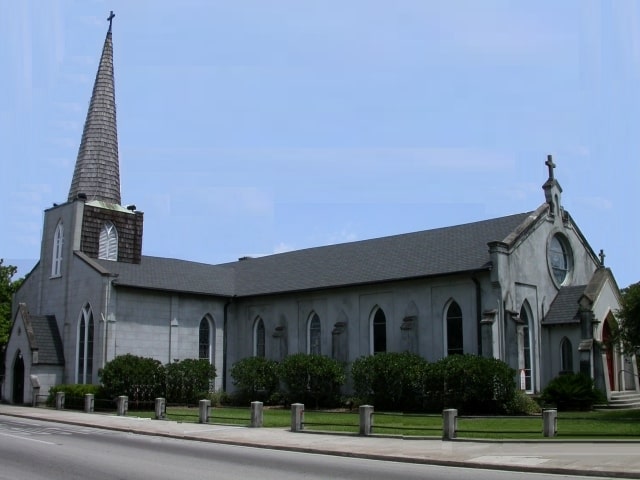
Episcopal church in St. Augustine, Florida. Trinity Parish is an historic Episcopal Church at the corner of King and Saint George streets in downtown St. Augustine, Florida. It is the oldest Protestant church in Florida and has some of the oldest and most beautiful stained glass windows in the Episcopal Diocese of Florida.[33]
Address: 215 St George St, 32084-4410 St. Augustine
St. Augustine Amphitheatre

Amphitheater in St. Augustine, Florida. The St. Augustine Amphitheatre is an outdoor amphitheater located on A1A in St. Augustine, Florida, United States. The venue seats over 4,000 persons, and is managed by the St. Johns County Parks & Recreation department.[34]
Address: St. Augustine, 1340C A1A South, St. Augustine, FL 32080-5422
Ortega House
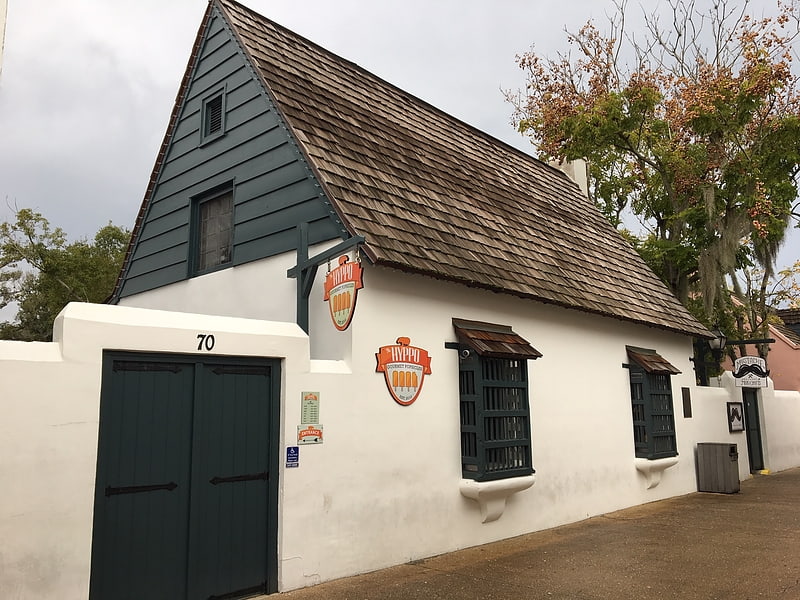
The Ortega House is located at 70 St. George Street in St. Augustine, Florida. It is a reconstructed home representing the architectural style of the First Spanish Period in Florida.[35]
Address: 70 St. George Street, St. Augustine